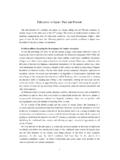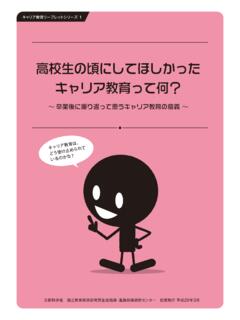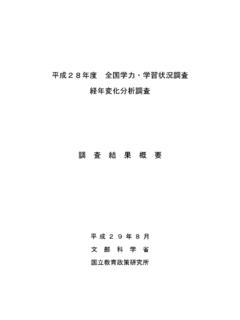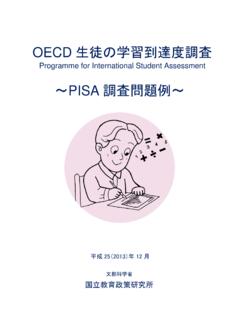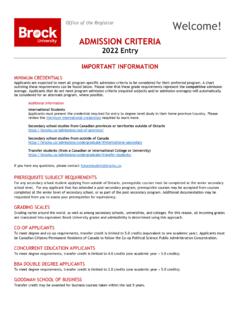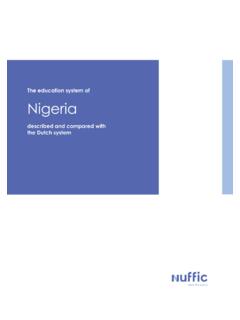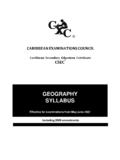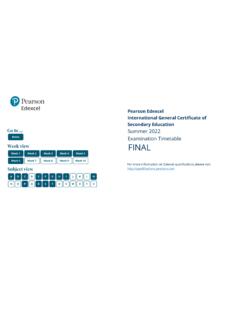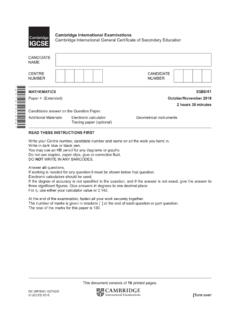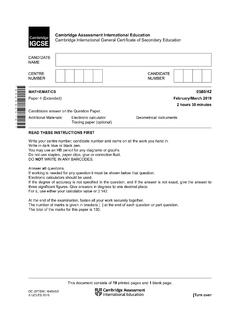Transcription of Teacher Training and Certificate System
1 Teacher Training and Certificate System 1. Teacher Training Teacher Training in Japan started with the establishment of normal schools (schools for Teacher Training ) in 1872. In 1886, a higher normal school was established. Elementary school teachers were trained by normal schools, and normal school and secondary school teachers were trained by higher normal schools. The current System of higher education was inaugurated in 1949 by the post-WWII education reforms, and the present Teacher Training System began. The traditional normal schools were abolished. In order to produce diverse human resources with broad outlooks and highly specialized knowledge and skills, at least one national university that had a faculty of education or a Teacher Training college was established in each prefecture, and it was decided that Teacher Training would be offered by these universities (the principle of Teacher Training in colleges and universities).
2 In addition to this, it was decided that after having the Teacher Training courses accredited by the Minister of education , Culture, Sports, Science and Technology (MEXT), any national, public, or private university could be equally involved in Teacher Training under this System (the principle of an open System ) by offering their students classes that provide the required number of credits for them to acquire teaching certificates. As of May 1, 2008, 582 out of 729 universities ( ) (47 out of 73 national universities), 423 out of 597 graduate schools ( %), and 277 out of 385 junior colleges ( %) had Teacher Training courses. More than 70% of institutions of higher education have Teacher Training courses. A different teaching Certificate earned through these university and college Training courses is required for teaching at each level of schooling, such as kindergarten, primary school, lower secondary school, upper secondary school, and special needs education .
3 In addition, there are teaching certificates for school nurses and diet and nutrition teachers that are independent of school levels, and which are also earned through universities and colleges. Laws and regulations have established the minimum number of credits that a person must acquire in the Teacher Training courses at universities, graduate schools, and junior colleges. Table 1 shows the basic requirements and the minimum number of credits to obtain a teaching Certificate . Table 1: Basic Requirements and Minimum Number of Credits for a Teaching Certificate Type of Teaching Certificate Basic Requirements Minimum Number of Credits Teaching Subjects Pedagogical Subjects Teaching subjects or pedagogy Special Needs education Subjects Kindergarten Advanced Master s Degree (ISCED 5A second degree) 6 35 34 Type I Bachelor s Degree (ISCED 5A first degree) 6 35 10 Type II Junior College Associate s Degree (ISCED 5B first degree) 4 27 Primary School Advanced Master s Degree (5A second degree) 8 41 34 Type I Bachelor s Degree (5A first degree) 8 41 10 Type II Junior College Associate s Degree (5B first degree) 4 31 2 Lower secondary School Advanced Master s Degree (5A second degree) 20 31 32 Type I Bachelor s Degree (5A first degree)
4 20 31 8 Type II Junior College Associate s Degree (5B first degree) 10 21 4 Upper secondary School Advanced Master s Degree (5A second degree) 20 23 40 Type I Bachelor s Degree (5A first degree) 20 23 16 Special Needs education Advanced Master s Degree (5A second degree) and a general Certificate to teach kindergarten/primary/ lower secondary /upper secondary school 50 Type I Bachelor s Degree (5A first degree) and a general Certificate to teach kindergarten/primary/ lower secondary /upper secondary school 26 Type II a general Certificate to teach kindergarten/primary/lower secondary /upper secondary school 16 In addition to the above, each student is required to complete two credits of coursework in subjects involving the Constitution of Japan, physical education , foreign language communication, and the use of information devices.
5 It also requires that students who aspire to earn teaching certificates for primary or lower secondary schools participate in nursing, assistance services, or communication with the elderly and/or people with disabilities for more than seven days at an institution for social welfare and/or special needs. 2. Teaching Certificates The teaching certificates for kindergarten and primary school are issued for the relevant level of school, and teaching certificates for lower secondary school and upper secondary school are issued by school level for each teaching subject. Teaching certificates for lower secondary school are provided for such teaching subjects as Japanese, social studies, mathematics, science, music, fine arts, health and physical education , health, industrial arts, home economics, vocational subjects, vocational guidance, vocational practicum, foreign languages, and religious education .
6 In the same manner, teaching certificates for upper secondary school are provided for such teaching subjects as Japanese, geography and history, civics, mathematics, science, music, fine arts, arts and crafts, calligraphy, health and physical education , health, nursing, nursing practicum, home economics, home economics practicum, agriculture, agricultural practicum, industry, industrial practicum, business, business practicum, fishing, fishing practicum, mercantile marine, mercantile marine practicum, vocational guidance, foreign languages, and religious education . A new type of secondary schools was introduced in 1998, one that provides both lower and upper secondary level education for a total of six years. There is no single teaching Certificate for both, and teachers need to acquire teaching certificates for both lower and upper secondary school.
7 However, it is possible for a person with a teaching Certificate for only one of these levels to teach at that level alone for a certain period of time. As a general rule, special needs education teachers must acquire both a teaching Certificate for the relevant level of school (kindergarten, primary school, lower secondary school, or upper secondary school) and a teaching Certificate for special needs education . However, if a person has a teaching Certificate either for kindergarten, primary school, lower secondary school, or upper secondary school, he/she may work as a Teacher in special needs education for a certain period of time. Three Types of Teaching Certificate There are three teaching certificates, which differ in acquisition method and validity, namely the regular teaching Certificate , the special teaching Certificate , and the temporary teaching Certificate .
8 * Regular Teaching Certificate The regular teaching Certificate is the most popular, and is usually referred to as a teaching license. This Certificate is issued by the prefectural boards of education upon a student s completion of the necessary Training programs in a Teacher - Training course at a university or Teacher Training institution designated by MEXT. A regular teaching Certificate is valid for all prefectures in Japan. The period of validity is 10 years, and it can be renewed by taking a Certificate renewal course given by a university. Regular teaching certificates are further categorized into Advanced, Type I, and Type II certificates, depending on the Teacher s academic background. A master s degree is the basic qualification for an advanced Certificate .
9 To earn such a Certificate , a person needs to obtain more than a certain number of credits for teaching subjects and professional subjects at a graduate school, in addition to the requirements for a Type I Certificate . A bachelor s degree is the basic qualification for the Type I Certificate , and in general, a person needs to obtain more than a certain number of credits for teaching subjects and professional subjects at a university to earn it. An associate degree from a junior college is the basic qualification for a Type II Certificate . Teachers with Type II certificates are requested to try to acquire Type I certificates in a suitable or related field, to the best of their abilities. * Special Teaching Certificates A special teaching Certificate was introduced by a revision to the Act on the Certification of Educational Staff in December 1988.
10 This aims to provide certificates through Teacher examinations in each prefecture, in order to employ a variety of people with superior knowledge, experience, technique, social prestige, ambition, and insight in education . The special teaching Certificate is issued based on employer recommendation (adopting board of education , school, etc.) after an interview with specialists. This Certificate is valid only in the prefecture that provides it. The valid period of the Certificate is for 10 years, and can be renewed just like a regular Certificate , by taking a Certificate renewal course. The number of special teaching certificates that were issued from 1998 to 2001 was very small. However, this number has increased every year due to a relaxation of the requirements from 2002.
